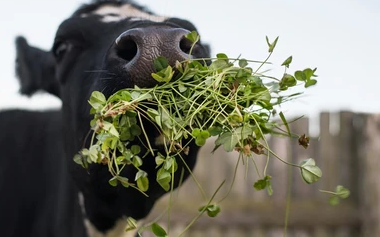Table of Contents
- 25 Animals That Eat Grass
- 1. Rabbit
- 2. Horse
- 3. Cow
- 4. Giraffe
- 5. Wildebeest
- 6. Antelope
- 7. Capybara
- 8. Giant Panda
- 9. Hippopotamus
- 10. Red Kangaroo
- 11. Goat
- 12. Elephant
- 13. Camel
- 14. Squirrel
- 15. Moose
- 16. Rhinoceros
- 17. Emu
- 18. Manatee
- 19. Llama
- 20. Guinea Pig
- 21. Quokka
- 22. Green Sea Turtle
- 23. Beaver
- 24. Sloth
- 25. Duck
- 26. Grasshoppers
- 27. Geometric Tortoise
- 28. Grass Skipper Caterpillars
- 29. Canada Goose
- 30. Mites
- Final Words: Animals Eat Grass
Key Points
- The only value that grass initially appears to have is the capacity to enhance the verdant, natural beauty of our surroundings.
- However, some animals have a biological advantage that allows them to unlock the goodness of their digestive systems.
- Arthropods, birds, and ruminants are among these fortunate creatures; this diverse group serves as evidence of how beneficial grass can be to the right stomachs.
For humans, pasture grass that isn’t made of corn, wheat, or other cereal grains isn’t the healthiest option, but it’s perfect for other animals. This is because animals that consume grass have sufficient amounts of the cellulase enzyme, which breaks down the cellulose in grass, produced by microorganisms in their gut. Because humans lack this enzyme, grass simply passes through the digestive system without making any positive contributions. However, grass is surprisingly high in protein, carbohydrates, minerals like iron and phosphorus, as well as vitamins C and E. Fiber is naturally present in large quantities.
The creatures on this list have digestive systems that enable them to consume the nutrients in grass. Others occasionally need to add fruit, seeds, leaves, or bark to their diets while some people can live off of only grass and still be healthy. Find out about 30 animals that consume grass by reading on.
25 Animals That Eat Grass
1. Rabbit
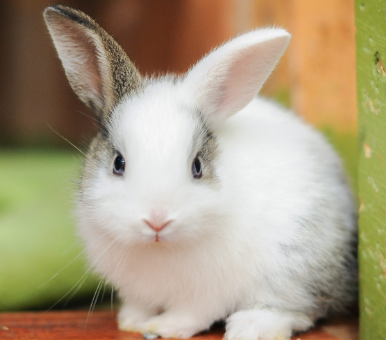
Rabbits enjoy eating grass and stealing some recent grass cuttings from property owners’ lawns.
Rabbit owners are aware of how much their pets enjoy being watched while in the backyard.
Before taking your pet rabbit outside to eat grass, however, there are a few things to think about.
It is important to make sure that the lawn has not been treated with pesticides or other bug repellents before letting your rabbit enjoy the grass and fresh air outside.
Because these substances are toxic to rabbits, they risk making them very ill or even killing them.
Your bunny will enjoy playing on a natural lawn.
While some domesticated rabbits don’t enjoy eating grass, wild rabbits will gnaw through your entire lawn.
You should gradually introduce grass to domesticated rabbits who do enjoy eating it in small amounts.
2. Horse
Horses consume a lot of pasture grass each day, which helps to keep them in good health.
Their dental health benefits from the silica in the grass they eat.
A horse can consume about 25 pounds of grass in a day.
Despite the fact that a horse’s mouth is excellent for chewing food, it is not used for breathing.
Only their noses are used by horses to breathe.
With about 10 gallons of saliva produced daily, a horse’s mouth is overflowing.
Horses with more teeth are males.
Males have 40 teeth, while females only have 36.
3. Cow
On lengthy country drives, most people have witnessed herds of cows peacefully munching on the grass.
You might not be aware of how much grass cows consume.
A minimum of one acre of land is required for someone to be able to own a cow.
The 25 to 30 pounds of grass that each cow needs to eat each day must be grown on an acre of land.
They weigh about 3% less as a result.
Cows will chew 40 to 50 times per minute for at least eight hours every day.
There are more than 8,000 distinct cow breeds.
For various purposes, including producing milk, beef, and leather, various breeds of cows are bred.
In the US, there are currently 98 million cows.
4. Giraffe
The majestic, tall giraffe typically enjoys munching on leaves and other tall vegetation.
To compensate for the lack of food, they will eat grass when food that is close to their faces is difficult to find.
Giraffes spend 75% of their day eating.
To have enough energy to walk and run, their large bodies require a lot of food.
They can run 10 miles per hour for long distances and 35 miles per hour for short distances.
Giraffes must spread their legs and bend down to touch the ground.
They consume grass and hydrate in this manner.
Fortunately, giraffes only require a few sips of water a day because they consume plenty of water-rich plants.
5. Wildebeest
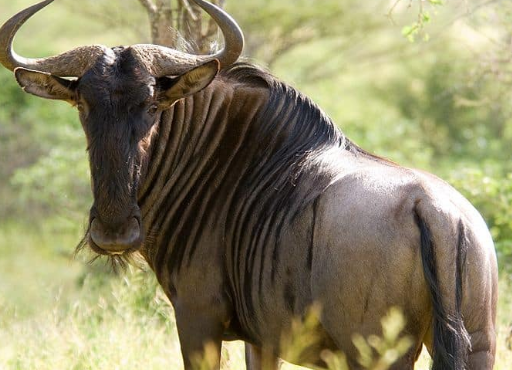
The main nutrient source for wildebeests is grass.
To find enough grass for the entire herd to eat, they will roam with their thousands-strong herd.
Grazing takes up a third of a wildebeest’s life, and sleeping takes up the other half.
A wildebeest can run at a top speed of 50 miles per hour, especially when lions, hyenas, and leopards are pursuing them.
Although they rarely grow taller than 4.5 feet, they can weigh up to 600 pounds.
The size of their horns is the most straightforward way to distinguish a male wildebeest from a female wildebeest.
Males typically have horns over 30 inches long, while females typically have horns between 12 and 16 inches long.
As they age, their horns’ bases become more ragged.
6. Antelope
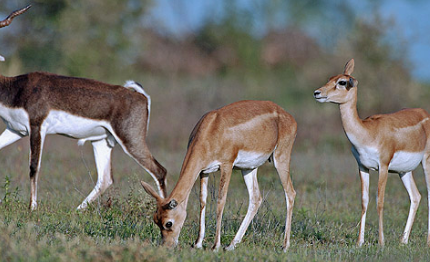
Normally, antelopes graze on grass wherever they go as they are herbivores.
Grass is the only food that all members of one species of antelope consume.
In their African grassland homes, grass is a simple food source.
About 15 to 20 antelopes make up herds.
Each herd of adult male antelopes only contains one individual.
Male calves are banished from the herd after age three, but female calves are permitted to stay with the herd.
The next oldest male antelope becomes the new leader when herds split into families as a result of their excessive size.
To ensure that they can find enough food while roving the grasslands, they maintain small herd sizes.
Antelopes can be in danger during feeding time because this is when lions and other predators most frequently strike.
Antelope defend their calves and females with their razor-sharp horns.
7. Capybara
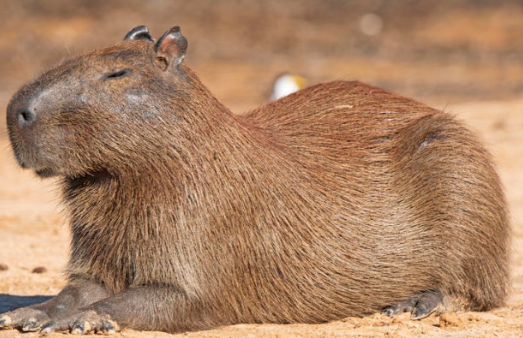
Giant, cute rodents called capybaras graze on grass all day long.
Although capybaras enjoy eating grass, they also need to consume their own waste.
In fact, the bacteria in a lot of rodents’ feces is very good for their digestive systems, giving rodents advantages comparable to what people get from yogurt.
They eat a few other plants and grass, which accounts for about 75% of their diet.
A capybara will consume six to eight pounds of grass every day.
They stand about 1.6 feet tall and can weigh anywhere from 60 to more than 170 pounds.
East of the Andes Mountain range, in Central and South America, capybaras are a common sight.
Capybaras adore the water and frequently snooze on the banks of rivers, leaving only their noses exposed.
8. Giant Panda
No other animal on earth loves bamboo more than the giant panda, which is a species of grass.
A day’s worth of bamboo for giant pandas ranges from 20 to 40 pounds.
In captivity, some pandas can consume up to 80 pounds of bamboo in a single sitting. These magnificent animals will spend half of their day eating bamboo.
Over five feet tall and weighing over 100 pounds, giant pandas are the largest species of panda.
The giant panda’s main concern is its food supply.
Because they simply don’t care to reproduce, giant pandas are critically endangered.
Their preference is food.
Pandas eat so much food that they end up excreting up to 60 pounds of waste every day.
They consume only fiber-rich bamboos, which are all edible.
Although pandas have the teeth necessary to eat meat, they prefer to stick to berries and bamboo.
9. Hippopotamus
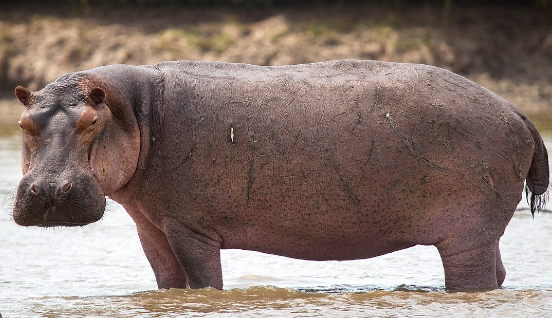
Massive African animals known as hippopotamuses enjoy eating short grass.
Each day, they eat only grass for five to six hours.
Hippos will journey five miles or more in search of grass to eat.
A hippo will end up consuming 150 pounds of food daily.
Hippos are fiercely protective of their turf, but only in the water.
For hippos, the water is a crucial habitat.
Hippos mate there and give birth there as well, keeping their delicate skin moisturized.
Anyone attempting to enter a hippo’s water will be charged by the animal.
10. Red Kangaroo
The grass is their favorite food, and red kangaroos are nocturnal herbivores.
The largest kangaroo species is the red kangaroo.
They weigh between 40 and 200 pounds and stand between five and six feet tall.
They can live for 16 to 32 years and were one of the first animals to represent Australia.
Despite being Australia’s national animal, kangaroos can get Australians into all kinds of trouble.
The same problems that raccoons cause can also be caused by kangaroos, including car accidents.
The Australian government has urged citizens and visitors to eat more kangaroo meat in an effort to reduce the kangaroo population.
While producing similar amounts of meat, kangaroo farms produce fewer emissions than cow farms.
Kangaroo meat is edible and can be used to make pizza, sausages, and steaks.
11. Goat
Since goats consume so much grass, some people have goat herds in place of lawnmowers.
The daily grass requirement for goats is two to four pounds.
Goats have four compartments in their stomachs to help them digest all the grass they consume.
The rumen is the name for one portion of a goat’s stomach.
Food that requires more chewing by the goat is regurgitated by the rumen.
Goats burp a lot as a result of this.
Following proper chewing, the grass enters the reticulum.
The grass travels to the abomasum, the last stomach, after passing through the third stomach, known as the omasum.
12. Elephant
Elephants eat grass to fuel their massive bodies.
They require 250–300 pounds of food each day.
Up to 600 pounds of food can be consumed by elephants every day.
Additionally, elephants require 25 to 50 gallons of water daily.
The largest brains of any land mammal, elephants are exceptionally intelligent creatures.
Their brains can weigh between eight and twelve pounds.
The heart of an elephant can weigh up to 50 pounds.
Elephants have the world’s longest eyelashes, with an average length of five inches.
The elephant is huge in every way, even its appetite.
13. Camel
In the desert, it may be difficult to find food.
Camels will consume nearly anything, but they favor grass.
Every day, camels consume about nine pounds of grass.
Camels only have three stomachs, whereas goats have four, but both animals regurgitate their food to chew on later.
Since camels are aware that there isn’t much water in the desert, they can drink up to 40 gallons in a single visit to a watering hole.
80 pounds of fat can be stored in a camel’s humps, where it is kept for times when there is not enough food.
The single-humped dromedary camel and the two-humped Bactrian camel are the only two varieties of camels.
14. Squirrel
When they are unable to find anything else to eat, squirrels will consume grass, but they prefer to consume grass seeds.
Because they don’t have particular food preferences, squirrels will consume almost anything they can get their hands on.
They have been seen consuming fruits, vegetables, cheese, nuts, birdseed, fungi, eggs, and even cat or dog food that has been left outside.
The average body weight of a squirrel is 1.5 pounds, and they consume that much food each week.
These little, active creatures require as much food as they can get.
Squirrels do not hibernate for a very long time compared to other mammals.
Because of this, you can frequently see them storing nuts in their homes before winter even arrives.
15. Moose
Moose are magnificent grass eaters, consuming 50 to 60 pounds of food each day.
Moose enjoy eating the leaves and berries from bushes in addition to their main food source, which is grass they graze on.
Their stomachs can support up to 112 pounds.
With weights of up to 1,400 pounds, moose are the biggest members of the deer family.
Despite their enormous size, moose have a top speed of 35 mph.
In addition, they have a six-mile swimming speed, which is faster than Olympic swimmers!
16. Rhinoceros
To maintain their massive size, rhinoceroses depend on the grass.
A rhinoceros needs 120 pounds of grass to survive.
Female rhinoceros and their young travel in groups called “crashes”, while male rhinos will live by themselves, only finding females when it is time for them to mate.
Mothers and their young rhino calves travel together because young rhinos are tasty targets for lions.
Attacking lions will be trampled by rhinos and pierced by their recognizable horns.
17. Emu
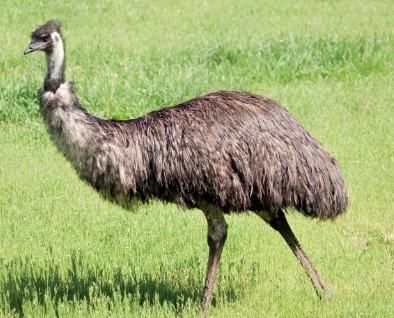
Emus are omnivores and will consume a lot of grass along with grubs and other insects that the bird eats.
The male emus will eat even more food before nesting season to bulk up for nesting season.
Even though female emus are the ones who lay the eggs, they are not involved in caring for the egg or the chick that emerges from it.
The males are the ones who construct the nest, warm the egg, and then care for the chick.
When the mothers try to intervene, the fathers frequently yell at them to leave.
18. Manatee
Massive marine mammals called manatees adore eating sea grass.
Daily consumption of sea grass by a manatee is 100 pounds.
In addition to constantly chewing, manatees eat for six to eight hours each day.
These enormous sea creatures eat so loudly that the sound of their teeth grinding can be heard underwater.
Manatees may also consume crayfish, crabs, leeches, and starfish in order to get all the food they require each day.
Manatees are omnivores despite frequently being mistakenly classified as herbivores.
19. Llama
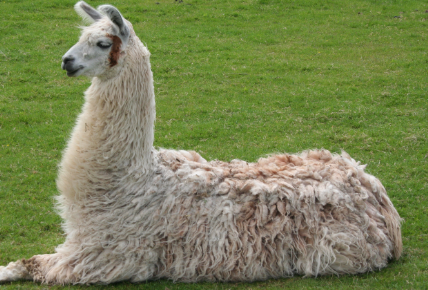
Even in captivity, llamas will primarily require grass to eat.
Although they can’t handle weeds or other tougher foliage, llamas contribute to fertilizing the pastures they graze on.
Three to five llamas can graze in an acre of space.
Llamas are far more intelligent than they appear.
They make excellent watchdogs for flocks of sheep or goats due to their social nature and intelligence.
The distinction between friendly and dangerous animals can be made by llamas.
Their sociability will often lead them to “adopt” other groups of animals.
20. Guinea Pig
Choosing a guinea pig as a first pet is common because they are cute and simple animals to care for.
Owners of guinea pigs are well aware of how much their animals enjoy being outside and consuming weeds and flowers.
As long as the grass hasn’t been treated to kill weeds or bugs, guinea pigs can eat a handful of it every day without any problems.
When bringing their animals outside on wet grass, guinea pig owners should exercise caution.
Ringworm can develop in guinea pigs who spend too much time in wet grass.
Mold can easily grow on wet grass, which is dangerous for them.
21. Quokka
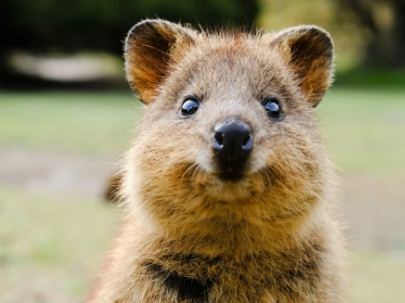
Thanks to their happy faces and fascination with people, quokkas have gained notoriety.
From Rottnest Island, which is close to Australia, come these amiable rodents.
They enjoy eating berries and other plants in addition to grass, which they eat primarily.
Quokkas are sadly in danger.
Because of logging and urbanization on their island, they have lost their homes.
Except for people, they have no predators on the island.
Even though quokkas are very social animals, it is best to avoid petting or feeding them.
22. Green Sea Turtle
As they age, green sea turtles consume an increasing amount of grass.
Sea turtles initially consume a wide variety of insects and crustaceans, but by the time they are fully grown, they are herbivores.
It is more difficult to catch moving prey when green sea turtles are older because they lose their agility.
Green sea turtles can grow to be over three feet in diameter and weigh well over 300 pounds.
A sea turtle will only ever reach adulthood once in every 10,000 eggs that it hatches.
23. Beaver
Despite their reputation for devouring wood, beavers eat a variety of other things as well.
These hardworking animals prefer a diet that balances soft and hard foliage.
Grass is the soft plant life that beavers prefer to eat.
Because of the excess iron in their teeth, which gives beavers their orange-colored teeth, beavers are able to cut through wood.
Additionally, while consuming wood, beavers sharpen their teeth, allowing the white enamel of their teeth to gradually become visible.
24. Sloth
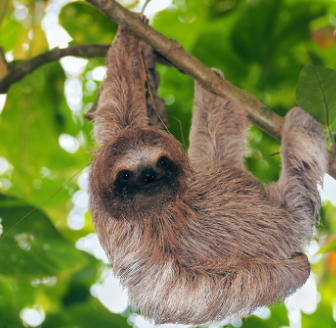
Grass and other plants are favorites of sloths to eat.
Sloths enjoy grabbing a bite of grass to eat while using the restroom, despite the fact that they only lower themselves to the ground to use the restroom.
Additionally, they pass a third of their weight in one bathroom visit.
Although sloths have 30% less muscle mass than humans, they are three times as strong.
They sleep by hanging from branches, which has given them all of their muscle mass.
The microbes in sloths’ stomachs that break down all of their food can be killed if it gets too cold for them.
25. Duck
Ducks will consume grass, weeds, larvae, slugs, snakes, and even frogs in the wild.
They are omnivores as a result.
Ducks, whether domestic or wild, adore eating greenery, with grass being a clear favorite.
Ducks occasionally eat sand, gravel, and stones.
They do this so that they can store and digest food in their gizzards.
Some gold prospectors discovered tiny gold nuggets in the gizzards of ducks they had shot in 1911.
Ducks don’t have any preferences when it comes to food.
Anything will satisfy them.
26. Grasshoppers
Naturally, these insects prefer grasses like quackgrass, junegrass, Johnsongrass, and even the Kentucky bluegrass found in lawns due to their renown for having strong back legs. They are so fond of grass that hordes of it, including the kinds of grass that people eat like corn, wheat, and oats, can be completely destroyed. Some grasshoppers, like the green-striped, like to nibble the blade’s edge about halfway up, chew through the leaf, hold on to the portion that was removed, and then use their feet to transfer it to their mouths. The grass will be chewed to the crown by other grasshoppers.
They can be kept from doing much damage to your garden by tilling the soil, which will reduce their activity. Mid-fall and early spring are the best times of the year to ensure that both eggs laid during the summer and those intended to hatch soon are impacted. Encouragement of the presence of birds can act as a deterrent to them because they favor areas with dense growth.
27. Geometric Tortoise
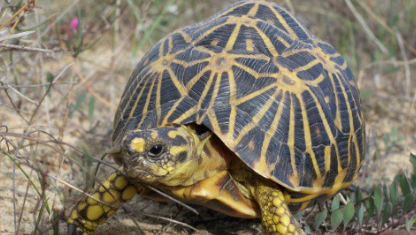
The Cape Province in South Africa is home to this tortoise, which is specialized in eating grass. It is true that the starry design on its rounded shell likely evolved to serve as a form of camouflage as it moves through the grasses it consumes. Found in a shrubby habitat called the renosterveld, this tortoise likes to restrict itself to such grasses as red oat grass, Bermuda grass, Briza maxima and Pentaschistis curvifolia which is also native to the The tortoise avoids hard-to-dig-up plants because it simply rips them out of the ground while grabbing them with its mouth.
28. Grass Skipper Caterpillars
The caterpillars of these unassuming little butterflies with their clubbed antennae eat grasses while other moth and butterfly species eat fancy plants like viburnum, milkweed, blueberries, blackberries, sassafras, witch hazel, and wild and domesticated crucifers. The caterpillars themselves are unassuming, with large heads and plain bodies in shades of green or brown. They graze on purple top, bent grass, orchard grass, bluegrass, rice cutgrass, timothy, and love grass.
29. Canada Goose
This large goose is native to North America and is recognizable to most people by its brown body, black neck and head, and white cheek patches that converge under the throat. Although they don’t only graze on grasses, they do so occasionally, particularly in the warmer months. They take the grass blade in their beak and pull it up, just like the geometric tortoise. They can then consume the roots as well as the blades and stems. The geese also consume the seeds that the grass produces.
30. Mites
The invertebrate species known as mites are not insects. They have eight legs, are spider relatives, and even produce webs. These webs could be the first indication that there is a mite issue with a lawn. A magnifying glass is required to see the mites because they are so small. They feed on the underside of the grass blade, which makes them even harder to see. They can be particularly annoying during times of drought, but it’s unusual to have an infestation that causes significant lawn damage.
Final Words: Animals Eat Grass
The base of every ecosystem is grass.
Small prey animals couldn’t survive without grass because it provides them with a sufficient source of food.
For these prey animals to successfully reproduce, there must be enough grass available.
By doing this, you can be sure that the predators are receiving the food they require to maintain a low enough prey population.
Without grass, ecosystems would collapse.
